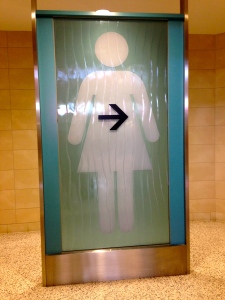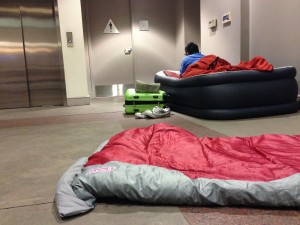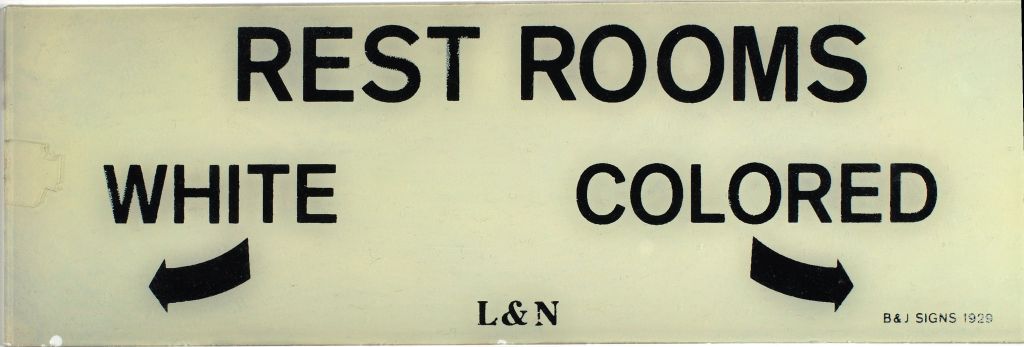Three-Year Mark
Posted: February 21, 2015 Filed under: Ken® | Tags: voicekwon Comments Off on Three-Year MarkI’m not sure how this happened but I have now been blogging about toilets in jazz clubs for three years. Those years have flown by and I’ve grown much; you may have witnessed a piece of this growth if you have been following this site closely. I started allotting just one space after the period and my views on clear and economical comma usage are continuing to evolve. I have yet to feel like I can use the adjective “killing” in an authentic way and not feel like I’m using it as a parody of the jazz musician—I think I’ve accepted that day may never come.
I checked out many venues and musicians I wouldn’t have seen if it weren’t for the need to review a new space. I met lots of people to ask for translations of “Where’s the restroom?” in their native as well as adopted tongues and am currently tweeting one a day for this month with #JT3yr to commemorate the third year. I also got to work with a great team of friends. Before Ken® was let go, he appeared in each post; you can play “Where’s Waldo?” on this site and look for him in photos up to Thanksgiving 2013.
Thanks in part to this blog, I’ve learned to harness the power of processing and uncovering ideas through the act of writing and have even been given a job as a writer/editor. On a somewhat related note, I once was attempting to type on my French friend’s laptop when I noticed that it was very difficult for me to do so because it was a different keyboard from that I was accustomed to typing English, Korean and Portuguese. I asked him why the French bother to have a different layout instead of just sticking to the QWERTY one. He replied by saying that it is a means of having power because control over language equals power. Doesn’t that make perfect sense?
 In many ways, this has been a documentation of my life in New York City. I feel that I really live here now having gone through the all-too-common “That’s it! I’m moving back to LA” phase and having stayed, yet feeling no strong pull to stay despite my close friends and communities here.
In many ways, this has been a documentation of my life in New York City. I feel that I really live here now having gone through the all-too-common “That’s it! I’m moving back to LA” phase and having stayed, yet feeling no strong pull to stay despite my close friends and communities here.
This third year marks the end of regular reviews and I don’t know if and when I will blog on here again. If you think you might miss my voice, don’t worry—you’ll be able to hear it through many other outlets.
It’s time for me to go and focus on other creative endeavors, among them making plus size fairy art and singing/composing for my new indie electronic band.
Thank you for reading, thank you for your encouragements, thank you for the curiosity. I hear the Village Vanguard has renovated their restrooms since the first review in 2012. Maybe I’ll see you there. Feel free to tweet or email me anytime. Take care and please remember to flush!
Black American Music
Posted: February 6, 2015 Filed under: Ken® | Tags: voicekwon 2 Comments »“It’s like a white person playing kayagŭm.”
Driving back from a show at a LA jazz club where the musician took care to identify as a Black American Music (BAM) artist, my sister and I were conversing about the performance when she drew a parallel between a white person playing jazz and a white person playing kayagŭm, a 12-string Korean traditional instrument.
Flabbergasted and absolutely incredulous, I yelled back that it’s not the same thing; white people can’t play Korean music without internalizing the essence of the music stemming from the lived history and sense of Han that Koreans collectively harbor from hundreds and hundreds of years of oppression under invasions from neighboring superpowers and colonialism. But it’s different with jazz!
“How is it different?” she asked.
…
I tried to formulate my defense but began to realize that there wasn’t much to say. There was a time when jazz too was folk music, music rooted in a history and struggle, music that belonged to Black Americans. The difference is that Korean traditional music still very much belongs to Koreans whereas jazz has been appropriated to the point where I can forget about its origins if I’m not relentless about reminding myself. It’s pretty scary that I’ve been schooled in jazz for over a decade from my beginning at an arts high school to graduate school in a prestigious jazz program and had trouble seeing past a shallow revisionist account of jazz history.
Sure, we laughed in jazz history class about Paul Whiteman, the white man who was hailed as the “King of Jazz” back in the 20’s, but there was no real discussion on the politics of race and power and its influence on the music. Even when trumpeter Nicholas Payton started writing about and coined the term Black American Music on his blog, I understood his points on an intellectual level but didn’t care enough to thoroughly re-examine my paradigm.
I see now that this is not about jazz vs. BAM but about something that needs to be in the greater public discourse and has been with the much-publicized feud between Azealia Banks and Iggy Azalea. When my sister and I got home from the show, we grabbed In-N-Out and stayed up watching the interview below in which Azealia Banks articulates why she has a problem with Iggy Azalea, the self-described “runaway slave master,” becoming the face of rap/hip-hop. The segment on “cultural smudging” starting at 8:35 might be the best jazz history lesson I never received.
In Azealia Banks’ own words:
“Just in this country, whenever it comes to our things–like black issues, or black politics, or black music or whatever–there’s always this like undercurrent of kind like a f–k you, there’s always like a f–k you all ni–as, like you all don’t really own sh-t, like you all don’t have sh-t, you get what I’m saying?”
“So this little thing called hip-hop that I’ve created for myself that I’m holding onto with my dear f—ing life, it’s like, you know, it just feels like it’s being like, like snatched away from me or something.”
On the history of slavery and the lack of reparations:
“At the very f—ing least you owe me the right to my f—ing identity and to not exploit that sh-t, you get what I’m saying? Like, that’s all that we’re like holding onto, like hip-hop and rap.”
I think Azealia Banks must be one of the sharpest minds in popular culture. Fully aware of the long history of white people’s appropriation of black people’s creations and accomplishments as their own, she is vigilant about making sure that her genre doesn’t suffer a fate similar to jazz. I see now why Nicholas Payton wants to distance himself from jazz and be associated with Black American Music, a name that makes its origin clear.
@JAZZTOILET @AZEALIABANKS 🙂 Ha. Now you get it… Shout out to Azealia for speaking to White appropriation of Black culture. #BAM
— Nicholas Payton (@paynic) February 10, 2015
I can already hear some responding by saying “hey, it’s all about the music”—it must be nice to have that kind of privilege, to not have to acknowledge the issues. I’m willing to guess based on past experience that some of those same people would jump on the chance to profit from the injustice suffered by the communities of color under the guise of bringing the matter to attention or something like that. Here’s a good rule of thumb: it’s not okay to appropriate someone else’s suffering for your profit.
I’d like to point out one more thing that you may or may not have noticed. I’ve gone to over fifty jazz-presenting venues in New York City in my three years of reviewing bathrooms for this blog. Guess how many of them were owned by black people?
Zero.
Here’s one more quote from Azealia Banks on the upcoming awards that are supposed to represent artistic excellence in hip-hop, among other categories:
“When they give these Grammys out, all it says to white kids is–oh yeah you’re great, you’re amazing, you can do whatever you put your mind to. And it says to black kids–you don’t have sh-t, you don’t own sh-t, not even the sh-t you created for yourself. And it makes me upset.”
It makes me upset too.
Thanksgiving
Posted: November 27, 2014 Filed under: Ken® | Tags: voicekwon Comments Off on ThanksgivingThanksgiving is here once again. This year I would like to share a holiday greeting from Crescent the Chromatic Bear.
I imagined the bear over a recording of Coltrane’s Crescent while still enrolled at Manhattan School of Music, hoping that he would catch on as the mascot of my master’s degree class. MSM would do well to have a furry creature for a mascot because its red M does nothing to cultivate allegiance to the school from students and alumni. My undergraduate institution had a mascot named Oski and I still closely identify as a Cal bear and feel deeply grateful to Berkeley. And need I mention the difference between the way people view Herbert Hoover who got a dam named after him and Teddy Roosevelt who got the teddy bear?
Press the bear’s nose below to hear his message.
Apologies if the video is blocked in your country. If you are celebrating Thanksgiving in the States, I hope today provides some respite from the chaos and darkness in our world and that you enjoy the time with friends and family.
Takeaways from MuseumCamp
Posted: August 12, 2014 Filed under: Ken® | Tags: voicekwon 1 Comment »I recently went to camp at the Santa Cruz Museum of Art & History (MAH) and spent several days and nights with museum professionals, arts consultants, community organizers and the like, convinced that this year’s theme of social impact assessment would have something to do with the themes I explore on this toilet blog. After breaking up into teams, each team identified a social outcome to measure at a local site in Santa Cruz. Teams tested hypotheses ranging from watching films at the Del Mar Cinema increasing civic pride for locals to people with a shared affinity in a specific artist being more likely to interact with strangers at the Kuumbwa Jazz Center. You can read about the projects here — my team project is the one with the typo that says “pubic art” instead of “public art.”
I found that many of the questions that the teams raised to formulate the hypotheses were of the sort that I think about when I review sites for JAZZ TOILET: Who is coming to these places? How is the organization serving its community? How is the community defined and who is excluded? Is this venue positively or negatively impacting the arts economy? How does the location and layout attract/repel certain populations? What relationship does the listener have to the music, to the venue?
 My head is full of questions, some seemingly too fluffy to be answered with hard data. MuseumCamp has taught me though that we can answer those questions by formulating hypotheses in response, identifying indicators, developing and using creative evaluation tools to measure the indicators, and analyzing the results.
My head is full of questions, some seemingly too fluffy to be answered with hard data. MuseumCamp has taught me though that we can answer those questions by formulating hypotheses in response, identifying indicators, developing and using creative evaluation tools to measure the indicators, and analyzing the results.
Moreover, conversations and moments at the Santa Cruz MAH have resparked my career as an artist, which has been largely dormant in my early retirement as a resigned twenty-something this past year. Place and posture can exert great influence on creativity and I discovered the museum to be an inspiring home. Feeling tired, I sat down on one of the two painted chairs in its three-floor elevator; the act of sitting in a museum elevator spurred me to think that my Brazilian Jazz duo should perform in elevators.
A term often applied to bossa nova in a derogatory fashion, it would be interesting to turn “elevator music” on its head and provide world-class bossa nova to anyone that enters the elevator. Live elevator music would be the antithesis of elevator music. If you see a person with a MuseumCamp patch on her backpack scoping out elevators in Manhattan, that’ll be me. Please feel free contact me if you have suggestions for elevators or are interested in having me in your elevator. And as they say on Craigslist, serious inquiries only.
Other than learning that the immeasurable is measurable and feeling rejuvenated creatively, I came back from camp thinking that when I grow old, I would like to be one of those people that pronounces the words humor and human with a Y instead of an H sound, just like my team mentor Paul Harder. My sister advised against it, however, and said that I would have to also pronounce the word schedule without the hard C sound so now I’m on the fence about it.
Finally, my only regrets from MuseumCamp are the following: not walking to the beach to see the seals; forgetting the proper pronunciation of the word lanyards; and not getting to meet all ninety-nine of the other happy campers. Thanks to Fractured Atlas for sending me to camp, Nina Simon and Ian Moss for being the best camp counselors and fellow campers for sharing much of themselves. Camp buddies for life!
Everybody needs a vacation.
Posted: July 29, 2014 Filed under: Ken® | Tags: voicekwon Comments Off on Everybody needs a vacation. Feeling a bit burnt out after last month, I’ve decided to take a summer vacation and so there will not be a post for July and maybe even August. A bit of a personal update, but what’s not a personal update on here?
Feeling a bit burnt out after last month, I’ve decided to take a summer vacation and so there will not be a post for July and maybe even August. A bit of a personal update, but what’s not a personal update on here?
I’m thrilled to be heading home to California tonight for MuseumCamp at the Santa Cruz Museum of Art & History. I hear we will be learning about social impact assessment and exchanging lanyards. I’ve never done formal research in social impact and haven’t made lanyards since elementary school, so I’m sure it will be an enriching experience.
I hope that you, too, are having an enriching and enjoyable summer.

